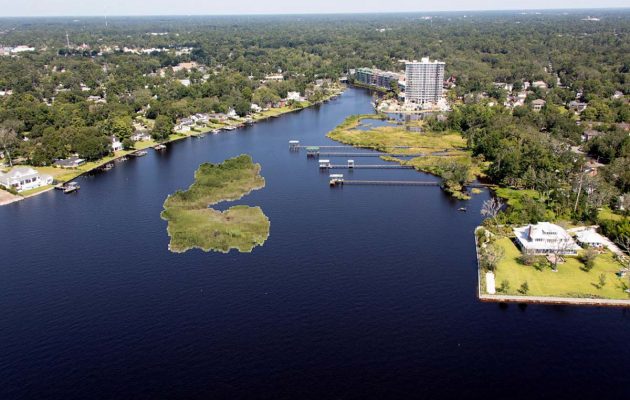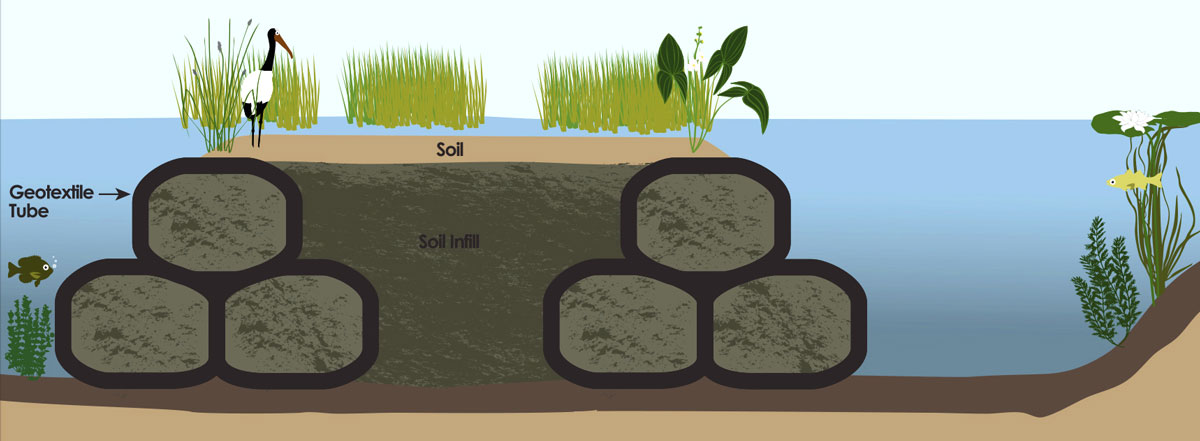Fishweir Creek restoration project faces several hurdles
Posted on October 1, 2018 By Editor Articles, Neighborhood News, Top Stories

Despite support for or grumblings against the Army Corps of Engineers’ proposed aquatic habitat ecosystem restoration project on Fishweir Creek, the project has four hurdles to overcome, each of which could stop it in its tracks.
The project goals include restoring the historic estuary to healthy levels which have been reduced by decades of urban development; restoring the habitat for federally-endangered manatees; improving water quality and tidal flushing actions; creating protective and forage habitat by planting vegetation, and encouraging wildlife habitat with removal of invasive plant species.
At a public meeting Sept. 20 at Willowbranch Library, Jason Harrah, ACE senior project manager, said the first potential obstacle to achieving those goals involves gaining permission from property owners in the project area to allow temporary easements along their waterfronts. Should any of the properties have Spanish Land Grants, which puts the property line in the middle of the waterway, not at the edge of the property, and a property owner is not willing to grant the easement, the restoration project could be halted as early as January.
“If any homeowner said they want to be compensated for the muck [that will be dredged], then we could have an issue, because we are not getting into buying real estate,” said Harrah.
According to the Corps’ schedule for design and permitting, the City of Jacksonville will undertake the easement agreements for completion by the end of December. Over the next three months, the Corps will survey the creek channel, identify property lines and springs, and mark utilities.
The second hurdle involves the Florida Department of Transportation’s concerns that dredging could impact the 58-pier Herschel Street bridge support system. Harrah said although the Corps had communicated early on in the project with all potentially impacted parties, he had just recently received an email from FDOT’s James Knight, which said “The center portion of the bridge was built in the 1920s and is supported on piles of unknown length. Due to this unknown condition, FDOT cannot determine the impact to the bridge support system from dredging the bottom down +- 5 feet to improve hydraulic and environmental conditions on the creek. Therefore, unless the bridge is replaced with a new structure designed for the revised channel bottom, FDOT cannot support dredging beneath the bridge or adjacent activities that could cause the mud line at the bridge to lower. Currently, FDOT has no plans to replace the bridge.”
The design schedule indicates the Corps will complete hydraulic modeling and analyze bridge scour potential in early 2019, which could result in a no-go decision at the end of March unless the project can be phased to avoid that area until the bridge is replaced – which may not occur any time in the near future.
The third and fourth hurdles were suggested by a member of the public, who asked if contaminants in the sediment could be high enough to bring the project to a halt and if funding was an issue.
In addressing the potential for contaminated sedimentation, Mike Hollingsworth, a biologist with the Army Corps, said preliminary testing indicated some elevated levels of metals are present through stormwater runoff, but this is no indication the levels are high enough to not move forward with the project.
The final obstacle to beginning the creek restoration project is funding. Although the Project Partnership Agreement was signed between the Corps and the City on June 7, 2018, the 65 percent of the costs to be borne by the Corps still requires federal government approval.
Harrah said he will start requesting funds as early as the Corp’s fiscal year 2019. “The squeaky wheel gets the grease,” he said. “The more our congressional representatives are involved, the more they hear from their constituents, the more opportunity we’ll have to receive the funding.”
Duane Kent, a City Public Works project manager in attendance, indicated the City’s portion – 35 percent of the $6,539,700 construction cost – has been almost totally funded.
If all hurdles are cleared, actual construction could begin in early 2021, thus putting completion 20 years after the project was first initiated with a letter of intent in 2002.

Cross-section rendering of the marsh island proposed for the mouth of Fishweir Creek as part of the aquatic habitat ecosystem restoration project.
Residents express concerns
At the start of the meeting, Harrah emphasized the project was not a dredging project and the creation of a 2.3-acre marsh island was pivotal to the creek restoration efforts. Despite efforts to explain the necessity of creating the island, some residents were not convinced.
The island, which would be constructed from the dredged material and fully encapsulated in a submersed “geo-textile tube,” would be tear-drop in shape to create two navigable channels and increase the velocity of water flowing out to the St. Johns River.
“Any material less suitable, but not hazardous, would be placed in the portion of the tube near the bottom, with the cleaner material at the top,” said Harrah, who said without the island the creek flow would not be strong enough to move sedimentation out into the St. Johns River, defeating the dredging efforts. “If the island is moved over, all the sediment will collect and create a big shoal area, incurring a dredging event every three or four years.”
For those living along the creek who were concerned about the height of the island obstructing their views, the top of the island would be planted with native species of plants and grasses that would not grow any higher than 3 feet, said Paul Stodola, a Corps biologist.
Other concerns expressed included whether the island would attract bugs, would it withstand major storms or exacerbate flooding in the area, and would the new channels impact docks along the creek.
Harrah assured the audience the Corps would consider all storm conditions in the final design of the island, while Melissa Reynolds, Engineering Technical Lead, said “We would never build anything that would exacerbate flooding.” Harrah also said increasing the creek flow should reduce the number of insects which breed in stagnant water bodies, which is essentially the current condition of Fishweir Creek.
Regarding effects on nearby docks, the Corps plans to shift the final alignment of the creek as needed to avoid dock structures and current access.
By Kate A. Hallock
Resident Community News




 (No Ratings Yet)
(No Ratings Yet)




